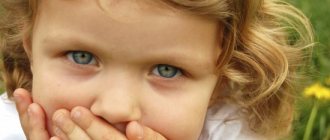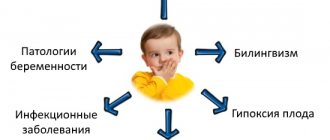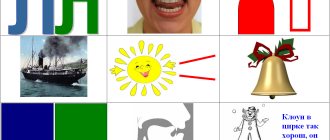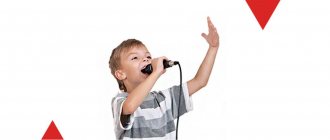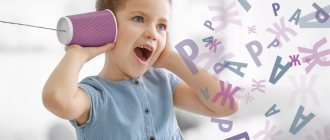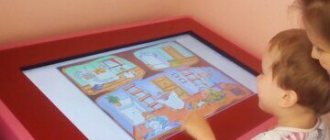There are certain sensitive (favorable) periods for the development of each mental cognitive process: thinking, memory, attention, perception and speech itself. It is very important that each stage of speech development, from humming to coherent speech, occurs in a timely manner. Starting speech in non-speaking children is a necessity if, at two years or more, the child does not speak at all, or pronounces babbling chains or several individual words.
It is very important for parents to understand that if you close your eyes to this problem, it will not only not disappear, but will only worsen the situation over time. Speech therapy work with non-speaking children should be carried out according to the characteristics and severity of the disorders.
What to pay attention to
When should you start sounding the alarm? So, this is necessary in cases where:
- The babbling chains of children are homogeneous, rare, and do not turn into words.
- By the age of 1.5 years, the intonation-rhythmic organization of speech in the baby is not formed.
- At 2-3 years old, a child does not understand speech addressed to him, even if an adult uses monosyllabic sentences and simple words.
- The child understands, but does not speak, or uses only a few words in communication. There is no phrasal, and especially coherent, speech.
- Physiological hearing impairment (deafness, hearing loss) was detected.
- The baby “speaks” in some kind of his own (bird) language, which no one understands.
Shoutout to the parents of a non-speaking child
As a result of such conversations, recommendations were drawn up for parents whose children cannot speak for a long time.
Tips for parents
- Talk to your child more, voicing all actions (feeding, dressing, bathing), commenting on the environment, not being afraid of repeating the same words, pronounce them clearly, patiently, and kindly.
- Develop understanding of speech using simple instructions such as “Give me a pen”, “Where is the leg?” Rely on what is available to the child. Repeat what you have already learned over and over again.
- In speech, use their simplified versions along with full words: car - beep, doll - la-la, fell - bang.
- Sing to your child before bed. It's better not to change your repertoire often.
- Create a desire to imitate an adult. This is possible when emotional interest and accessibility of words that the child pronounces during joint games are combined (Hide and Seek - peek-a-boo, Little Engine - tut-tu). You can be surprised together by what you see: “Wow!” The first words spoken against an emotional background can be interjections: oh, ah, uh. The child is allowed to repeat only vowels: o, a, u.
- Tell stories and read children's first fairy tales and poems more often. Encourage the child to complete the words to the best of their ability.
- Do not overload your child with television, video and audio information. When reading, reduce the text to understandable phrases.
- Do not talk in front of your child about his retardation.
- Don't be annoyed or embarrassed by what your child doesn't say. Do not show excessive anxiety: everyone has their own deadlines and their own problems.
- Without waiting for the child to speak. Start teaching him to distinguish objects by size (large - small); match colors, shapes (give me the same); quantity (one - many).
- Massage your fingers and palms, play games like “Magpie-White-sided”.
Causes and mechanisms of the disorder
The reasons may be social or biological. The first group includes:
- Lack of communication (verbal, emotional) between adults and the child. The experiment with infants is based on comparing the psycho-emotional state of the subjects. For a certain period of time, some newborn children were placed in a room with white walls, isolated from extraneous sounds and other external stimuli. The children were not picked up; they were only given the necessary care. In another room there was a second group of subjects, where a favorable environment was created, the babies were not only fed and swaddled, but also picked up, rocked, and talked to. At the end of the experiment, when summing up the results, it was noted that the mental development indicators of the children of the first group were significantly lower than those of the children of the second. This experience confirms the fact that the lack of an emotional connection between mother and child and a lack of communication can further negatively affect the formation of speech.
- Using multiple languages in the family. Bilingual children are the name given to those who are raised in a bilingual family. If a child is exposed to speech in different languages, then at some point “stupor” may occur. Speech therapy work with such children should be carried out only in one (leading) language; if this condition is neglected, the situation can be aggravated. It is also undesirable for several speech therapists to work with the child, since different specialists may choose different methods for training, which will only complicate the perception of new material.
Biological reasons:
- Difficult or unnatural labor (eg, caesarean section and prolonged labor).
- Fetal hypoxia (lack of oxygen) during intrauterine development, which in turn leads to disruption of metabolic processes and a delay in the formation of the central nervous system.
- Birth injuries in a newborn: if the cerebral cortex is damaged, if the speech zone is affected, the manifestation of pathology will definitely be the consequence.
- Head injuries, especially at an early age.
- Infectious diseases suffered in the first year of life, which subsequently caused complications.
Groups of words suggested for memorization.
1. Subject dictionary.
Toys: ball, cube, car, doll, bear, bunny, ball, spinning top, bucket, shovel, pencils, book, etc. Parts of the body, face: legs, arms, belly, back, finger, head, neck, hair, eyes , ears, mouth, lips, teeth, nose, cheeks, eyebrows, forehead. Clothing and footwear: hat, scarf, mittens, jacket, coat, dress, skirt, blouse, shirt, trousers, tights, briefs, T-shirt, socks, slippers, boots, shoes, sandals, etc. Toilet items: soap, toothbrush, toothpaste, sponge, towel, comb, handkerchief, etc. House, apartment: house, door, lock, key, stairs, elevator, window, kitchen, room, bathroom, lamp, floor, ceiling, wall, etc. Furniture: table, chair, sofa, bed, wardrobe, shelf, hanger, etc. Household items: TV, telephone, clock, stove, refrigerator, fork, spoon, plate, cup, blanket, pillow, mirror, etc. Food and dishes : bread, bun, cheese, sausage, sausages, milk, butter, sour cream, cottage cheese, yogurt, cookies, juice, egg; porridge, soup, salad, sandwich, tea, compote, etc. Vegetables and fruits: cabbage, potatoes, carrots, onions, cucumbers, tomatoes; orange, banana, apple, pear, plum, etc. Plants: tree, bush, grass, flowers, berries, etc. Names of animals and birds that the child often sees: dog, cat, bird, dove, sparrow, crow, horse, etc. etc. Individual names of objects in the surrounding life: street, road, traffic light, cars, plane, swing, slide, park, etc. Individual names of phenomena in the surrounding life: water, earth, sun, sky, rain, snow, night, day, etc.
2. Verb dictionary.
The child’s own actions: walks, sits, stands, runs, jumps, sleeps, eats, plays, draws, builds, walks, rolls, washes, bathes, dresses, undresses, combs his hair, carries, falls, screams, speaks, sweeps, wipes and etc. Names of actions that people close to the child perform: reads, writes, draws, cleans, washes, irons, cooks, fries, sweeps, etc. Other actions: the phone rings; the car drives and hums; The plane is flying; leaves are falling, etc.
3. Adjectives, adverbs.
Names of some sensations and states: sweet, salty, sour, wet; cold, warm, hot, painful, tasty.
The name of some concepts: big, small; a lot, a little.
Work to expand the passive vocabulary of non-speaking children 2-3 years old is carried out both by a speech therapist and by the child’s relatives. Therefore, a speech therapist not only works with the child, but also works with parents.
Classification of violations
A correctly made diagnosis plays a very important role, since the correctional technique included in the speech therapist’s work plan is effective for one type of disorder, but may be completely unsuitable for another. If we classify the types of speech disorders in non-speaking children, the following diagnoses should be noted:
- All disorders associated with speech pathology in children are combined into GSD (general speech underdevelopment). The diagnosis is general in nature, so if the child was given it after the examination, it is important to pay attention to its level, since OHP can be from the first to the fourth degree. If the speech therapy report shows ONR type I, this indicates that the child partially or completely lacks speech and (or) understanding of it.
- SSD (systemic speech underdevelopment) is a persistent disorder in children with disabilities (disabilities). Profound SUD is characterized by a disorder of coherent speech, a poor vocabulary and problems in understanding. The diagnosis can be made for children with mental retardation, severe mental retardation, cerebral palsy, etc.
- Alalia. This diagnosis indicates that the child either completely lacks speech itself or understands it. The first condition is typical for the motor type of pathology, the second – for the sensory one. If both reproduction and understanding are impaired, then a diagnosis of sensorimotor alalia is made. Such a conclusion can be given in parallel with childhood autism, but not necessarily. It should also not be confused with echolalia, a disorder in which there is repetition of ready-made speech structures: sentences, phrases, words. It looks like a child is imitating. The main task of this specific speech disorder, as paradoxical as it may sound, is interaction with others. Normally, all children repeat certain words or phrases after adults, this allows them to better remember new material and later use these constructions in their own speech. But in children with echolalia, this process stops at the initial stage. One of the main reasons for this may be damage to the central nervous system.
- Aphasia. This diagnosis can be made even to an adult. It differs from the previous one in that in this case certain speech areas of the cerebral cortex may be affected: the person will have difficulty expressing himself, or may not understand the speech addressed to him. Aphasia is often a consequence of a stroke.
- SRD (delayed speech development) is a lag behind the norms of development and formation of speech with initially intact intelligence. In other words, if a child uses only 5-10 words in his active vocabulary at two years of age, whereas normally these indicators reach 300-400, then, accordingly, the developmental disability is evident. However, only a qualified specialist can make an accurate diagnosis, since all types of disorders are similar to each other. If a baby at 2-3 years old uses only individual syllables or babble, and zero words, then this is not a delay; here the diagnosis will be more serious.
Most often, problems in the development of one mental function entail a lag in the formation of other cognitive components: when speech is delayed, attention, memory, and thinking are impaired. Therefore, at 3-4 years old, a child with mental retardation development will most likely be diagnosed with mental retardation disorder - delayed psycho-speech development. Children with this diagnosis are recommended to study in a correctional institution, since speech therapy work alone will not be enough in their case.
Several diagnoses can be written in the diagnostic chart at once. For example, they can write related ones, such as autism, echolalia, mental retardation, etc. However, you should not be afraid of the medical reports obtained based on the results of the examination. Effective comprehensive correctional work, especially started in the early stages, will bring it to a high-quality level and compensate for deficiencies in psycho-speech development.
For most of the listed violations, defectological assistance is required.
Starting speech in non-speaking children from zero to phrase speech is necessary primarily for those who suffer from alalia. The most difficult thing is to work with children diagnosed with the sensorimotor type of this disorder. In this case, other specialists are also involved, in particular, a defectologist and a psychologist are directly involved in the process of correcting disorders in alaliks. First, the work will be aimed at developing understanding, then only speech motor skills.
Big feet are walking along the road.
Goal: development of imitation of the movements and speech of an adult - repetition of amorphous words TOP-TOP; words LEGS, LEGS, ROAD; phrases BIG LEGS, LEGS GO, etc.; development of movements.
Progress of the game: Offer the children the game “Legs and Legs”. Let's play the game “Legs and Legs” - we will walk and run. Listen to the poem, repeat after me! Big feet walk along the road: TOP-TOP-TOP! (we speak in a low voice, raise our legs high, take long steps) Little legs run along the path: Top-top-top, top-top-top! (we speak in a thin voice, run in small steps) You can move in one direction, then in the opposite direction (corresponding to the first and second parts of the poem), or you can move in a circle. Make sure that all children have enough space to perform their movements.
Development of verb vocabulary.
Particular attention should be paid to teaching children the use of verb words (action words), since they play a key role in the development of children's speech. Such verbs include: GIVE, NA, GO, KATI, LOVI, STAY, etc. Young children can be offered easier (“childish”) versions of some verbs
For example: sleeping - BAY-BAY; gets up - AP-AP; eats - AM-AM; washes - BULL-BULL; walks - TOP-TOP; fell - BANG; swings - KACH-KACH; bathes - KUP-KUP; laughs - HA-HA-HA, etc.
Literature
- Zhukova N.S., Mastyukova E.M., Filicheva T.B. Overcoming general speech underdevelopment in preschool children - M.: Education, 1990.
- Kataeva A.A., Strebeleva E.A. Didactic games and exercises in teaching mentally retarded preschoolers. – M.: Book-master, 1993.
- Kozak O.N. Games and activities for children from birth to three years old. – St. Petersburg: Union, 1998.
- Gromova O.E. Hello! Lala? Speech. The first verbs - M.: Karapuz, 2003.
- Gromova O.E. Top top. Buh. Speech. The first verbs - M.: Karapuz, 2003.
Read part 1 of the article HERE
Corrective work for sensory alalia
Speech therapy work with non-speaking children 3-4 years old suffering from alalia is structured depending on the type of this disorder. If a diagnosis of sensory alalia has been established, then the speech understanding disorder will be corrected by working with intact analyzers, that is, through tactile, olfactory, gustatory and visual perception. The auditory system is not ignored, but is included in the work partially and only at later stages.
There are several stages of work to correct and eliminate speech disorders in the sensory type. Conventionally, they can be divided into:
- Stage I – preparatory.
- Stage II – formation of communication skills (from non-speech to speech).
- Stage III – development of interest in surrounding non-speech and speech sounds.
First stage
Before starting correctional work to eliminate speech disorders, it should be understood that, although it is customary to take methodological developments adapted for hard of hearing and deaf children as a basis, nevertheless, lack of hearing and misunderstanding of speech are two completely different concepts and require radically opposite in some cases approach. This must be taken into account when choosing techniques and methods for teaching children with sensory alalia.
These children hear, but the process of analyzing the information received is disrupted: the auditory analyzer can perceive the signal at the moment, but after some time under the same conditions it cannot. In the familiar environment of their home, they can remember individual speech structures used by adults. At the same time, when they find themselves in an unfamiliar environment, or when they come into contact with a new person, they do not understand the same statement. The auditory system of alaliks is extremely unstable; children with this perception disorder have a hard time tolerating sharp sounds (creaks, rustling), high-frequency noises, screaming or loud expressive speech. All this can lead to blocking the acoustic-gnostic process, which will only complicate the correction work. Therefore, during classes with such children it is necessary to use calm, quiet speech so as not to reduce their perception of speech sounds.
Often concomitant disorders in children with sensory or sensorimotor alalia are disturbances in the emotional-volitional sphere and behavior, so at first, classes with the child will most likely be chaotic, spontaneous. Under no circumstances should you try to force an alalik to “sit” in one place for a certain number of minutes. One of the main initial tasks is to establish contact with the child at the level of tactile and visual perception. Only after contact has been established can work begin, otherwise all efforts will go down the drain.
Second phase
Children, through joint play activities with a teacher, learn to use non-verbal communication skills - gestures, facial expressions. Later, semantic intonation is added. This happens when playing partner games with a child, for example:
"Feed the doll." The speech therapist speaks and shows what needs to be done: sits the doll on a chair (at the table), holds a spoon to the toy’s mouth, imitating “feeding,” etc. The child, in turn, performs the same actions, duplicating gestures and facial expressions. Here, motor and visual analyzers are actively involved in the work, the “eye to eye” technique is used, which allows the baby to better understand what the adult wants from him. However, this method is not suitable for children with autism, as they often tend to avoid eye contact with other people.
Games with construction sets or cubes will also be useful. This version of “parallel play” is also suitable for autistic people. Tactile and visual perception and sensation are involved. The teacher builds a tower or other structure together (if this does not cause negative emotions) or next to the child, using facial expressions and gestures. Speech is minimal, simple, monosyllabic, there should not be too many words in use, it is better to rely on those that the child perceives or can often hear.
You can also work with various aids for the development of sensory skills (color, taste, tactile features of objects) and fine motor skills: musical toys, soft and wooden cubes. The goal of the second stage is to directly formulate the need for verbal communication. It can be developed with the help of an artificially created “information hunger.”
Third stage
At this stage, the gradual development of phonemic hearing and perception begins. First with the help of non-speech sounds, then with the inclusion of adult speech. In this case, it is necessary to avoid sharp knocks, clapping of hands, and stomping. The sound is compared to the displayed image. For example, a speech therapist offers a pupil a number of illustrations for the development of subject vocabulary. Next, he parses each picture with one or more sounds corresponding to it (uu - paravoz, yy - bear, mu - cow, etc.). The same thing happens when the symbols of actions are activated: a selection of plot pictures allows you to expand the verbal dictionary (aa - cries, ay - hurts, etc.).
You can use ready-made material “My First Words” by N. A. Shishkina, developed in accordance with the modern psycholinguistic approach, and systematized into blocks for more convenient study of information. This manual is suitable for working with both sensory and motor skills.
Before starting work, it is recommended to establish a routine, clearly define the time for classes and rest. You need to try once again not to overload auditory attention and perception with speech tasks.
This stage will be fundamental in the development of speech understanding, as it will allow:
- intensify the use of words according to their purpose;
- develop the ability to analyze one’s own speech;
- replenish passive vocabulary, which, subject to the effective work of the speech therapist, will eventually turn into active;
- develop phonetic-phonemic perception: distinguish words that sound similar.
What activities can be done with your child at home for speech development?
It's no secret that children spend most of their time at home.
Note! Therefore, it is so important to properly organize the baby’s activities aimed at developing children’s speech.
Articulation gymnastics and pronunciation training
Basically, all speech therapy classes for children 3-4 years old begin with small gymnastics for the organs of articulation. Most popular:
- Smile - stretch your lips in a smile, showing your teeth (the same without teeth).
- Dudochka - fold your lips into a tube and stretch them forward.
- Balloon - inflate your cheeks and hold the air for 3-5 seconds.
- Shoulder blade - place your tongue outstretched on the lower lip and fix it.
- Needle - tighten the tongue very much, make it as thin as possible and pull it forward, fix it.
- Jam - lick your upper and lower lips with your tongue.
- Let's brush our teeth - run your tongue over the upper teeth, then over the lower ones.
- Hill - the tongue rests on the lower teeth, while the middle of it tends to the palate, forming a hill. With this training, the child remembers the position of the tongue used to pronounce many sounds.
Games for hearing development
Children of primary preschool age are offered games to distinguish the volume of a sound or recognize an object that makes a sound. For many speech therapy tasks offered to children 3-4 years old, musical instruments such as pipes, drums, and piano are used.
Also at this age it is already possible to teach a child to distinguish sounds by ear. This can be done by offering a game: “Clap your hands when you hear the song of the water (sound “S”): sleep, frame, braid, mom, Sasha, etc.”
Important! It is best to call sounds by special “names”: the sound “S” is the song of the water, the sound “Sh” is the hissing of a snake, etc.
It will be easier for the child to remember and navigate. When pronouncing a word in which the baby must highlight the sound, it should be exaggerated.
Finger gymnastics
This gymnastics is used as an activity for the development of speech for 4 years at home and in preschool educational institutions. By this age, the baby understands simple instructions and is able to follow them, and children's fine motor skills are already sufficiently developed to make small “compositions” from their fingers. Here are some of them:
- Lock - hands are tightly clasped in a lock, with the fingers of both hands intertwined with each other.
- Scratching - alternately depict “paws” with your right and left hands.
- Let's warm up our hands by rubbing our left palm vigorously with our right palm.
- Glasses - make a circle with the thumb and index finger of each hand and bring it to your eyes - put on glasses.
Finger gymnastics develops speech
Poetry learning, reading and storytelling
Children 3-4 years old often learn poetry, retell fairy tales, and learn to read during speech therapy sessions at home. This is facilitated by numerous manuals and workbooks for younger preschoolers, which can be purchased at any children's store or printed from the Internet.
The best authors of children's fiction: Korney Chukovsky, Alexander Pushkin, Agnia Barto, Samuil Marshak. The main task of memorizing short poems and retellings of works is to enrich the child’s vocabulary, expand his fantasy and imagination.
Note! In 2021 Bardysheva T. Yu
and E.N. Monosova published a special manual aimed at the comprehensive speech development of children of primary preschool age. The notebook by Monosova and Bardysheva consists of 120 pages of high-quality exercises and games that help increase the child’s active and passive vocabulary, develop phonemic awareness and coherent speech, and improve the processes of thinking, attention and memory. This manual was created both for professional speech therapists and defectologists, and for parents - it is written in simple and understandable language.
Corrective work for motor alalia
Motor alalia is characterized by underdevelopment of expressive speech or its absence; in this case, classes with a specialist will be aimed at starting speech. The preparatory stage of speech therapy work is aimed at evoking speech sounds, using the pitch, strength of the voice, and its rhythmic and intonation components. To do this, they use the method of “singing” vowels when merging sounds into syllables, or in isolation. At the same time, finger exercises, breathing and articulation exercises are used.
Corrective activities carried out at the main stage are based on:
- development and expansion of passive vocabulary;
- activation of new words;
- formation of the grammatical aspect of speech;
- formation of phrasal speech;
- development of coherent speech.
In the future, it will be necessary to correct the sound pronunciation. This work is carried out as part of the formation of a grammatical structure.
Evoking speech in non-speaking children with motor alalia, as well as with sensory alalia, is carried out in several stages from simple to complex, but with one difference: the need for communication in children of this group is not impaired, therefore the method of “information hunger” is not used in this case . On the contrary, a child with motor alalia needs qualitatively new information.
Initiating speech in non-speaking children: modern techniques
Before starting a child’s speech, you need to motivate the preschooler to clearly pronounce words, phrases, and then full-fledged phrases and sentences. To motivate him to communicate and stimulate mental development, you need to improve:
- touch;
- tactile sensitivity;
- sensory
What skills do preschoolers develop in dialogue?
To do this, you can use a range of children's educational games using didactic materials.
Forecasting and corrective measures
The sooner the work begins, the greater the chance of compensating for speech impairment in children with mild or moderate forms of underdevelopment of certain mental functions. The task of corrective influence on children with severe forms of pathology is to support and develop as much as possible communication and self-care skills, so that in the future special children have the opportunity to socialize in society.
The most important condition when starting a speech is the timeliness of correctional work and an integrated approach. In parallel with pedagogical classes, for any speech disorder that has a biological cause, a course of treatment with medications corresponding to the established diagnosis is prescribed. If the cause of mild RRD in a child with intact intelligence is found to be weak innervation of the organs of the speech apparatus, it is recommended to include speech therapy massage and articulation gymnastics in the complex of classes as a preventive measure.
If already at the age of 2-3 years the child was diagnosed with sensory alalia, and the baby’s parents turned to a speech therapist for help only at the age of 5-6, then you need to understand that the underdevelopment of speech has progressed over all this time. At this age, sensorimotor alalia is already established in all children.
Non-verbal children with disabilities are often homeschooled. Their parents are required to take a direct part in the speech therapy process.
9.A lot or a little?
Goal: to teach children to correlate the words “one”, “many”, “few” with the corresponding number of objects. Materials: in this game you can use small toys - cubes, sticks, balls, etc. Progress of the game: When forming the concepts of “one”, “many”, “few”, it is useful to teach children to use the appropriate gestures: “one” - show the index finger; “a lot” - a wide, circling hand gesture; “little” - a narrow, outward gesture with the hand, or fold your palms into a handful. To do this, the speech therapist constantly uses these gestures and encourages children to use them. The names of concepts should be highlighted in speech. The game is played on the carpet. Lay out the cubes in front of the children: one pile has a lot of cubes, and the other has few. Look, here are the cubes, and here are the cubes too. There are a lot of cubes here (the speech therapist shows the corresponding gesture), but there are few cubes here (the speech therapist shows the corresponding gesture). Show where there are few cubes. How do you show that there are not enough cubes? (the speech therapist encourages the children to show a gesture) Where are there a lot of blocks? How do you show that there are a lot of cubes? (the speech therapist encourages the children to show a gesture) And here is one cube. (the speech therapist shows the appropriate gesture) Take one cube at a time. Show that there is only one cube. (the speech therapist encourages the children to show a gesture) It is useful to repeat this game using different subject material.
10.Where is there a lot and where is there little?
Goal: to teach children to distinguish between the grammatical forms of singular and plural nouns. Materials: subject pictures that depict various objects in quantities of one or many (can be selected from visual material on the development of mathematical concepts). How to play: Place pictures in front of the children. Then give the task. Show me where the butterfly is. Where are the butterflies? Where's the ball? Where are the balls? Where is the flower? Where are the flowers? Etc.
11.Big or small?
Goal: to teach children to correlate the words “big” and “small” with the size of objects. Materials: in this game you can compare any toys and objects; You can use pictures in further work. Progress of the game: When forming the concepts of “big” and “small”, it is useful to teach children to use expressive gestures: “big” - spread your arms to the sides (or simultaneously up and to the sides), “small” - bring your palms closer to each other (or bring your hands closer to each other). index and thumb towards each other). To do this, the speech therapist constantly uses these gestures and encourages children to use them. The names of concepts should be highlighted in speech. Show the children the big and small balls. Look, here's a ball, and here's a ball too. Are the balls the same? No, the balls are different. This ball is big! (the speech therapist shows the appropriate gesture), and this ball is small (the speech therapist shows the appropriate gesture). What kind of ball is this - show me. (the speech therapist encourages the children to show the gesture) That’s right, small. What is this ball? Show! (the speech therapist encourages the children to show a gesture) It is useful to repeat this game using a variety of subject material.
